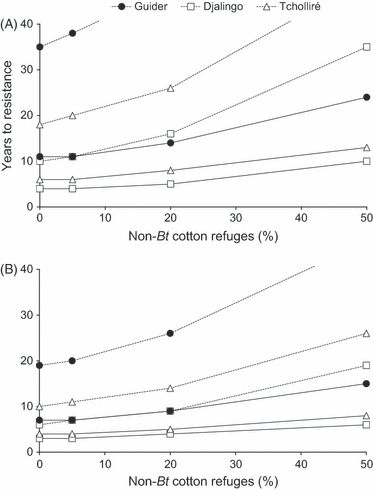Assessing the role of non-cotton refuges in delaying Helicoverpa armigera resistance to Bt cotton in West Africa
- PMID: 25568029
- PMCID: PMC3353336
- DOI: 10.1111/j.1752-4571.2011.00207.x
Assessing the role of non-cotton refuges in delaying Helicoverpa armigera resistance to Bt cotton in West Africa
Abstract
Non-cotton host plants without Bacillus thuringiensis (Bt) toxins can provide refuges that delay resistance to Bt cotton in polyphagous insect pests. It has proven difficult, however, to determine the effective contribution of such refuges and their role in delaying resistance evolution. Here, we used biogeochemical markers to quantify movement of Helicoverpa armigera moths from non-cotton hosts to cotton fields in three agricultural landscapes of the West African cotton belt (Cameroon) where Bt cotton was absent. We show that the contribution of non-cotton hosts as a source of moths was spatially and temporally variable, but at least equivalent to a 7.5% sprayed refuge of non-Bt cotton. Simulation models incorporating H. armigera biological parameters, however, indicate that planting non-Bt cotton refuges may be needed to significantly delay resistance to cotton producing the toxins Cry1Ac and Cry2Ab. Specifically, when the concentration of one toxin (here Cry1Ac) declined seasonally, resistance to Bt cotton often occurred rapidly in simulations where refuges of non-Bt cotton were rare and resistance to Cry2Ab was non-recessive, because resistance was essentially driven by one toxin (here Cry2Ab). The use of biogeochemical markers to quantify insect movement can provide a valuable tool to evaluate the role of non-cotton refuges in delaying the evolution of H. armigera resistance to Bt cotton.
Keywords: Bacillus thuringiensis; Bt cotton; biogeochemical markers; genetically engineered crops; insect resistance management; polyphagous pest; refuge strategy.
Figures




References
-
- Adamczyk JJ, Adams LC, Hardee DD. Field efficacy and seasonal expression profiles for terminal leaves of single and double Bacillus thuringiensis toxin cotton genotypes. Journal of Economic Entomology. 2001;94:1589–1593. - PubMed
-
- Akhurst RJ, James W, Bird LJ, Beard C. Resistance to the Cry1Ac delta-endotoxin of Bacillus thuringiensis in the cotton bollworm, Helicoverpa armigera (Lepidoptera: Noctuidae) Journal of Economic Entomology. 2003;96:1290–1299. - PubMed
-
- Bagla P. Hardy cotton-munching pests are latest blow to GM crops. Science. 2010;327:1439. - PubMed
-
- Baker GH, Tann CR, Fitt GP. Production of Helicoverpa spp. (Lepidoptera, Noctuidae) from different refuge crops to accompany transgenic cotton plantings in eastern Australia. Australian Journal of Agricultural Research. 2008;59:723–732.
-
- Bird LJ, Akhurst RJ. Relative fitness of CrylA-resistant and -susceptible Helicoverpa armigera (Lepidoptera: Noctuidae) on conventional and transgenic cotton. Journal of Economic Entomology. 2004;97:1699–1709. - PubMed
LinkOut - more resources
Full Text Sources
Other Literature Sources

